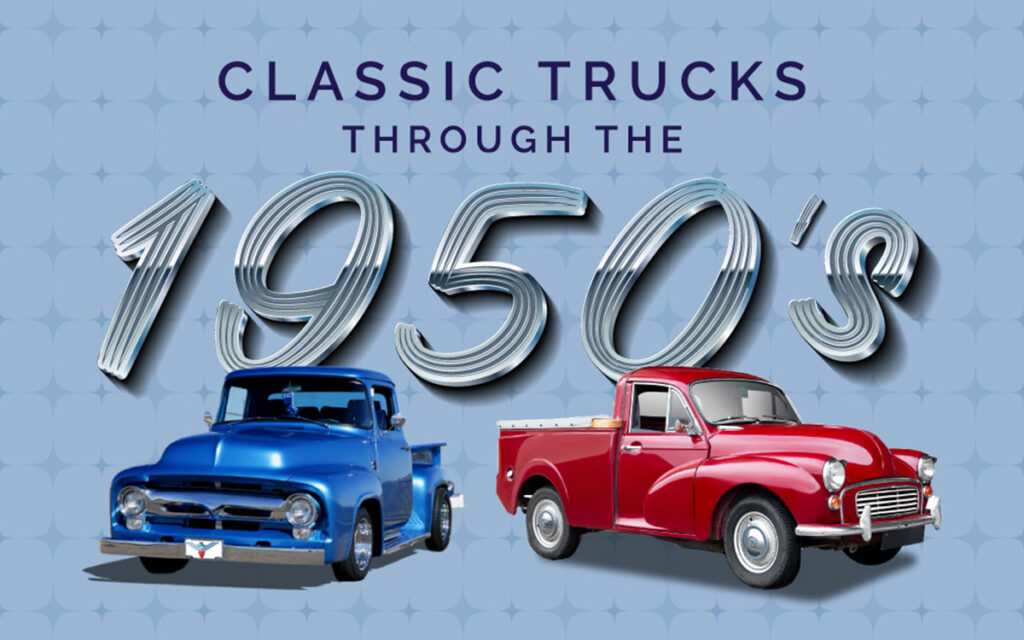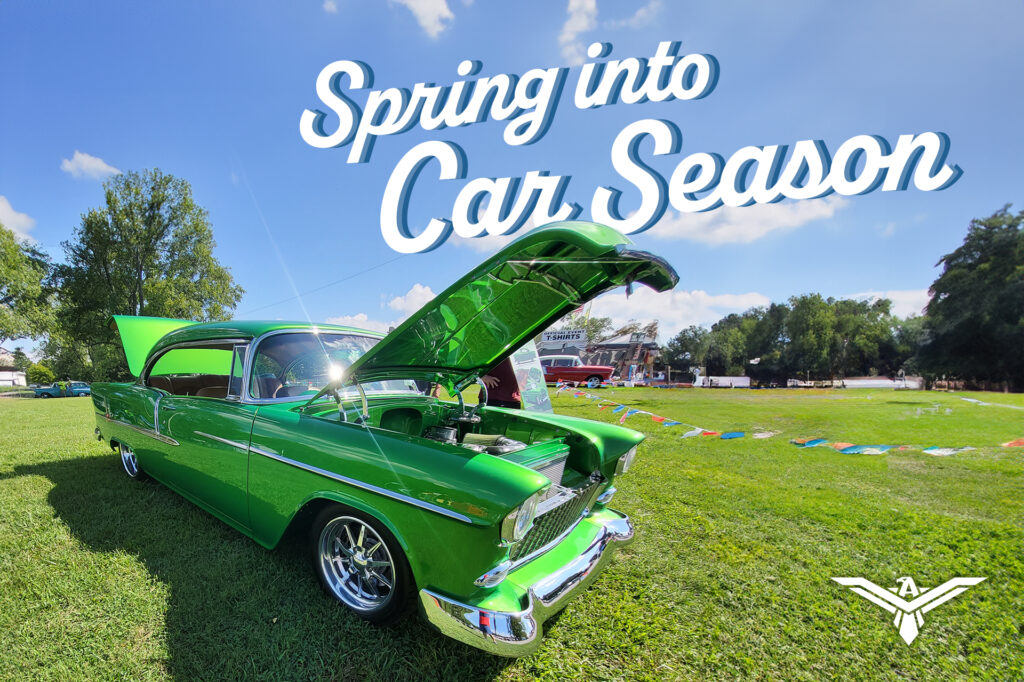A Look at the Most Iconic Pickup Trucks from the Fifties
Collectors’ love for classic trucks can be traced back to an era that marked significant growth and prosperity for the American automotive industry: the 1950s. At the time, the American car market was booming and the demand for semi-trucks and small trucks skyrocketed. The three most popular brands of the time, Chevrolet, Ford, and Dodge, were leading the charge in this new era of trucks.
The trucks of the 1950s had a very distinct and unique look. They featured real wood truck flatbed liners, curved lines, and brightly colored exteriors that made them stand out from the crowd. These classic trucks were not just workhorses but also prized possessions that people took pride in owning. In this article, we will take a closer look at some of the most iconic classic trucks of the 1950s, their design features, and their enduring legacy in American automotive culture.
Comparing the Best Vintage 1950’s Pickup Trucks
Interest in classic pickups has never been higher, and for good reason. They all have the charm of their passenger-car counterparts but can often be found for less money. As many “barn finds” today are trucks, there is significant interest in work vehicles with obvious patina. A vintage truck can be a wonderful link to the optimism and progress that defined the Fifties, and it can be a charming companion piece to the Big Three truck you might already own. To misquote President Herbert Hoover, “Why not have two trucks in every garage, and a chicken in every pot?”
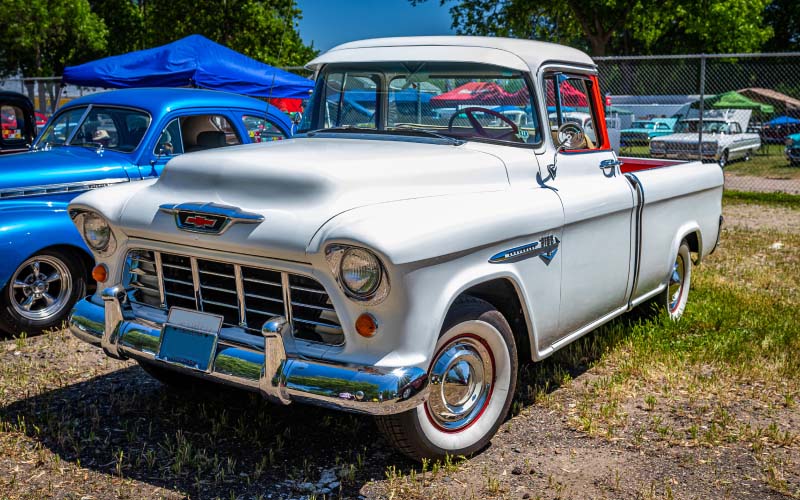
Chevrolet Task Force and Cameo
Chevrolet’s “Advanced Design” pickups of 1947 offered an unprecedented array of comfort and convenience features to half-ton buyers, from recirculating heaters to Delco radios. The “crank-out” windshield was gone, replaced by vents for passenger comfort. In 1950 the bar was raised further with telescoping shock absorbers and better seats. By 1955, however, the public was ready for something better, so the 1955 “Task Force” half-ton offered styling that was clearly inspired by Chevrolet passenger cars with a wraparound windshield and optional wraparound rear glass.
What really got people talking, however, was the “Cameo” model. It had smooth bed sides that matched the body contours of the cab, made by the same Ashtabula, Ohio supplier who produced the bodies for the then-new Corvette sports cars. In the back, taillights from the Bel Air sedan completed the look. It was marketed as “the executive truck” and it is arguably the most important single pickup truck in American history since the Model T; with just a few exceptions, every pickup sold in America since the Eighties has featured “Cameo” bed styling, which is now just called “Fleetside.” There were fifteen solid colors and fourteen two-tone schemes that highlighted a long Corvette-style “cove” on the bed sides.
As modern as the Cameo was, it still had a hardwood cargo-box floor for its 6.5-foot bed. The base Chevrolet truck still offered a nine-foot bed, something that fell out of favor quickly in the years that followed. In 1958, Chevrolet adopted its dual-headlight styling to a new half-ton “Apache” line. Today, all of the Fifties trucks from Chevrolet are valuable, but Cameos tend to be in a class of their own.
Unlike today, the GMC trucks of the Fifties had significant differences from their Chevrolet siblings. There was a Cameo equivalent, badged “GMC Suburban,” but all the GMC trucks had bespoke powertrains either developed within the brand or sourced from Pontiac. Late in the 1956 model year, GMC pioneered the factory availability of what was then still considered very much a niche-market option: four-wheel-drive, using components developed by NAPCO Industries. Customers who wanted a four-by-four Chevy would have to wait about half a year to have something similar.
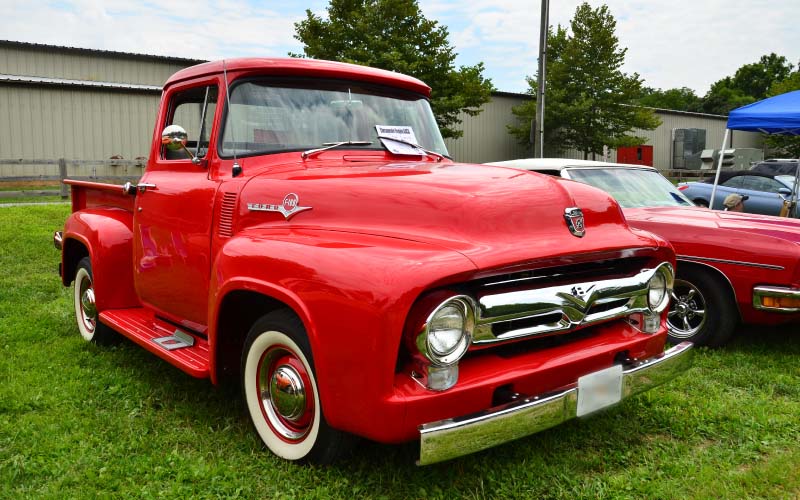
Ford F-Series
Chances are that you know Ford’s F-Series pickup truck has been the best-selling vehicle in America for a long time. How long? If the streak holds, which seems likely to be the case, 2023 will be the forty-second year of F-Series, notedly the Ford F-150, market domination. That’s staying power. The brand, and model, which held the sales crown for most of the decade before the big Ford – the Oldsmobile Cutlass – no longer exist.
We take for granted nowadays that half-ton pickup trucks from Ford, GM, and Ram dominate the market, but it was a gradual process that started more than seventy years ago, way back in the postwar Fifties. The Big Three and their scrappy competitors started the decade offering trucks that didn’t have much appeal beyond the farm and fleet markets – and ended it with glamorous, characterful vehicles that worked hard and offered showroom appeal.
Ford got a slightly slower start out of the post-war blocks than GM, but the 1948 F-1 made up the gap and then some. It had its own platform design, in contrast to the Advanced Design Chevrolet, which still used an older general-purpose passenger-car frame, it came standard with telescoping shocks, and it was the only small truck to offer a V-8 all the way through 1954.
1953’s F-1 offered a larger cab and plenty of mechanical enhancements, but it retained the tapered-nose styling of prewar cars and trucks, which didn’t play well in showrooms when compared to the sleek 1955 Chevy. So the new Ford 1957 F-1 had to be a hit – and it was. Powered by the same Y-Block V-8 that had replaced flatheads two years prior in the old truck, the 1957 Ford offered a “Styleside” bed to match the Cameo, and greater availability of options and trim levels to go along with it. A switch to quad headlamps helped the slightly frumpy-looking Ford keep pace with Chevrolet.
Mercury dealers got a badge-engineered version called M-Series, which had no mechanical differences. Both Ford and Mercury featured a clamshell hood offering a nice compromise between the modern styling of a flat hood and the increased engine access of a traditional truck bonnet. In 1959, Ford had yet another better idea: a four-wheel-drive system fully engineered and produced in-house. This was the critical step in making “4×4’ trucks the majority of production, something that didn’t happen until the turn of the 21st century.
As you’d expect, Styleside pickups in bold colors with plenty of factory options are at the top of most collector wish lists – but there’s plenty of nostalgia, and buyers, for the farm-and-fleet “Flareside” six-cylinders that were more common than Mail Pouch barn signs in rural America. The community of Flathead V-8 enthusiasts will prefer the earlier vintage trucks, of course, but a 1954 Y-Block half-ton can keep up with modern traffic… at least until it’s time to stop!
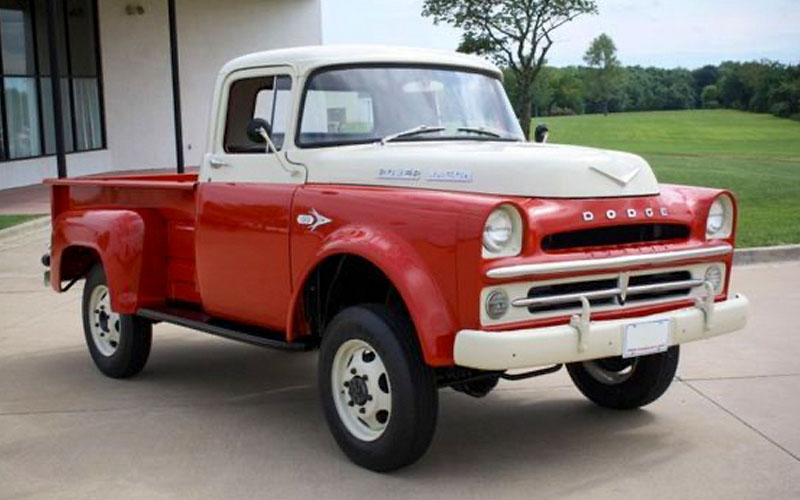
Dodge Power Wagon
You can’t talk about Dodge classic trucks of any era without mentioning the famous Power Wagons. Starting in 1934, the company had built 4×4 trucks for the armed forces – and although there were many “GIs” who came home from the war in love with their Willys “Jeeps”, plenty of returning soldiers preferred the far more robust and capable Dodges, which were sold to the public starting in 1946 as “Power Wagons”.
In 1950, the Power Wagon received significant upgrades all around, including a new pickup bed, better brakes, and “civilian style” instrumentation. Few changes were made across the decade, although the industrial-grade straight-six eventually made it to a robust 99 rated horsepower. It goes without saying that all these vehicles are highly sought-after today, with massive collector appeal, but they were popular with the public when they were new as well – enough so for Dodge to apply the “Power Wagon” name to 1957’s new 4×4 versions of its half-ton pickup, which shared virtually nothing with the original Power Wagon.
That’s not to say that the Dodge half-tons weren’t special, because they were. The B-series of 1948 applied new styling to prewar mechanicals, but the 1954 C-Series was all new, and they gained a wraparound windshield in 1955. In 1957, however, the stakes were definitely raised with the “Power Giants.” With optional Hemi V-8 engines and “Sweptside” bed styling to match Chevrolet and Ford, plus the aforementioned 4×4 Power Wagon option, these were formidable vehicles. Their considerable mechanical innovation and aggressive new styling couldn’t quite hide the fact that the Power Giants were restyled C-Series trucks under the skin.
Yet if you’re looking for an ancestor to the most popular modern pickups, with V-8 engines, automatic transmissions, and factory-supplied four-wheel-drive, Dodge is the first place you’ll find all three together. And in the unlikely event that you find yourself in a drag race between bone-stock Fifties half-ton truck, expect the Dodge to take home all the pink slips.
Vintage Truck Honorable Mentions
Another important part of the modern pickup, of course, is the “crew-cab” two-row seating arrangement, and that was debuted by the 1957 “Golden Jubilee” series of International Trucks. It wasn’t a four-door truck, mind you; rear seat access was on the right side of the cab with a single door in an arrangement familiar to anyone who had seen an International Travelall wagon, a fact reflected by the “Travelette” name. International also was the first company to offer two-tone paint on a pickup truck, a feature which even today finds some buyers in Ford’s upscale King Ranch F-Series.

Something else that wouldn’t shock a modern buyer dropped into a time machine: you could, of course, buy a Willys pickup truck with four-wheel-drive, badged “Jeep” starting in 1957. These were only available as one-ton trucks and therefore didn’t have a lot of customer overlap with the Big Three pickups. Just to keep things interesting, Jeep offered a “Forward Control” cabover variant, as did Land Rover in the UK.
Studebaker pickups of the Fifties continue to have real collector appeal, but the cash-strapped brand was unable to field an all-new truck for the decade. Although their 1949 “2R” pickups had a metal floor and aerodynamic bed sides, Studebaker never came up with a Cameo competitor. Four-wheel-drive was a late addition as well, arriving in 1958. There’s some niche interest as well in the bargain-basement “Scotsman” variants of 1958 and 1959.
As you’d expect, the classic trucks of the Fifties are generally simple and robust, intended to be fixed by their owners in the field. (In some cases, “field” was literally that – a farm field.) Parts availability is good, especially for the Big Three, and these vehicles are quite under stressed in daily use. Modern owners should make sure they pay maximum attention to the braking systems, which need to be kept in perfect order to avoid unpleasant surprises in today’s traffic.
